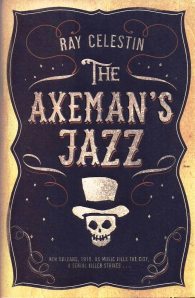 Writing historical crime fiction is no easy task: you have all the challenges of contemporary crime – a convincing plot and characters and a credible ending; suspense, tension, threat and so on – and you’ve also got to get those factual ducks in a row so that the time and place feel authentic and convincing.
Writing historical crime fiction is no easy task: you have all the challenges of contemporary crime – a convincing plot and characters and a credible ending; suspense, tension, threat and so on – and you’ve also got to get those factual ducks in a row so that the time and place feel authentic and convincing.
The Axeman’s Jazz tries really hard to do all these things, but doesn’t quite succeed at any of them. The result is a solid enough whodunit, set in New Orleans 1919, and it’s ram-packed with historical backstory… but it doesn’t feel like Louisiana just after WW1. The mere mention of Angola, the abusive plantation-turned-prison where men sold their souls, should produce a shudder. Every page should feel heavy with the oppressive, wet heat that saturates the city, but the Axeman’s Jazz didn’t bring to (my) mind the oozing booze Bourbon Street or the sugar-dusted beignets of the Café du Monde. The text has all the necessary information – maybe too much of it – but there’s no crackle of pecan shells underfoot, no faintly metallic scent of rising rot from the still waters in the swamps. And the interlocking three storylines, while an intriguing mystery and neatly plotted to involve genuine characters of the era, felt forced together in their final resolution.
On top of that, I kept being jarred from the historical narrative by modern attitudes which felt very much out of place in the Crescent City of a century ago. A sheltered young woman of colour, pale enough to pass for white, would’ve been eaten alive by the people she encountered while working for the Pinkertons detective agency (and would they really have employed her?) A man who had sex with girls or hit children would not have been considered especially unusual or a ‘child abuser’ – that term feels far too modern a phrase for what was pretty much normal behaviour in parts of the city. And would a corrupt cop, just released from the living hell that was Angola, really be in the least bit nostalgic for the security it provided to him? I kinda doubt it. Similarly, I stumbled in the story when cops have conversations by the water-cooler. Such moments felt out of place for pre-prohibition America.
The writing didn’t exactly sweep me along, either, laden down as it is by a metric tonne of historical references, which felt like they were present and correct to demonstrate the book’s credentials rather than establish an atmosphere or tell the story. The writing is fine, but the plot pace falters with so many street names and descriptions, and explanations about the difference between Creole and Cajun and black and Italian and so on. The Axeman’s Jazz tries to cram in absolutely everything, from vou dou to police corruption and a quick history of how the Sicilian mafia established themselves in the Southern states – this is one moment when less would have been more, I suspect.
However, one tip of the hat to historical fact which I did enjoy was the peripheral involvement of a young Lewis Armstrong – yes, that’s spelled correctly, before the pronunciation swapped to the French style Louis. It was interesting to be reminded of his back-story and early years. Indeed, where author Ray Celestin really succeeds is in re-telling the factual and historical aspects of the story; the Axeman murders did take place and there are several theories about who-actually-done-it. I can’t help thinking that this book might have worked better as a straight, true-crime non-fiction presentation with a choice of possible theories, rather than a somewhat over-stuffed novel.
Several writers, notably Anne Rice, Tim Gautreaux and of course the magnificent James Lee Burke have brought Louisiana, the birth of jazz and blues, and New Orleans itself to brilliant life in all its tawdry glory. The Axeman’s Jazz had a lot to live up to, and didn’t hit the mark – well, not for me, anyway.
6/10
Reviewed by Rowena Hoseason


